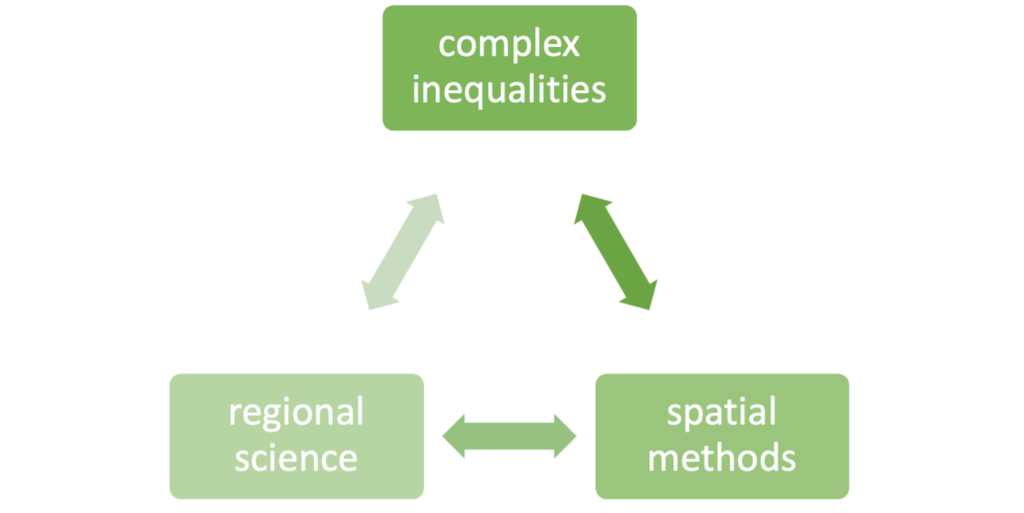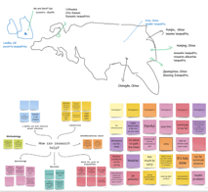Dr Zofia Bednarowska-Michaiel, Centre for Interdisciplinary Methodologies, University of Warwick
CIM finished the 2020/2021 academic year with a series of research workshops. The final one was called “Uncovering social and regional inequalities using spatial data and interdisciplinary methods”. During that workshop I talked about an interdisciplinary approach to inequalities, using spatial methods and regional approach. Here in this blogpost, I reflect on the researching inequalities, as well as briefly discuss implementing it in a workshop setting.
1 Introduction. What are inequalities, how do we define them?
Reducing Inequalities is one of the Sustainable Development Goals of the United Nations (United Nations, 2022). If you look at the full list of UN’s goals, you can notice that the rest of goals also concern inequalities of various kind e.g., gender or education inequalities, although the goals themselves are not called this way. Why do some inequalities receive more attention than others in research and policymaking?
I believe the reason for that is a common perception of inequalities primarily in economic terms, hence income inequalities attract the most attention. However, there are many more types of inequalities, often defined slightly different by various stakeholders and they are strongly linked to each other.
During CIM workshop, I drew my typology of inequalities. This includes social, economic, political and what I called – sectoral inequalities. If we were to start with social inequalities, we can differentiate inequalities based on gender, age, race, sexual orientation, ethnicity, nationality, class. These and other social categories of identity usually do not exist independently and require intersectional recognition in order to understand overlapping inequalities and discrimination.
Sectoral inequalities group those occurring within a given sector: health, education, income, environmental, transportation, technology. Most of inequalities touch upon a few sectors e.g., digital inequalities and they require intersectoral approach.
Following this typology further, all of inequalities can be understood at various scales – local, regional, national, or global. The question we discussed during a workshop is how we can research and then tackle inequalities within the regional scale. There’s a growing interest in inequalities, in particular urban inequalities as a research subject (Nijman and Wei, 2020). However, the benefit of regional outlook is a holistic approach to inequalities, regardless of region being more urban or rural, or a bit of both.
The concept of ‘inequalities’ is, in my opinion, just the first phase of disparities that eventually lead to exclusion and discrimination. This brings us to the conclusion that is essential to find effective way of researching inequalities in order to grasp their complexity and interdependency.
2. Methods. The trinity of interdisciplinarity
The workshop discussion was built around how interdisciplinary approach can help in researching complex inequalities. I have introduced three concepts that encompass the interdisciplinarity itself, as seen on the chart below:

The multi-dimensionality of inequalities requires a multi-level approach in research. I introduced the foundations of regional science and spatial methods during the workshop. This showed how they can work in recognition of complex inequalities that touch upon various sectors and scales.
Mapping inequalities with a regional outlook reveals significance of distance – how neighbourhood, borders, and spillovers affect and sustain inequalities. Introducing spatial component reveals different ways of looking into inequalities – we will see for instance, how social and racial inequalities are intertwined, together with economic or political inequalities.
The regional aspect of inequalities already has an interdisciplinary element engrained within. By focusing on a given region, we can then expand into different research areas. Regional science uses various disciplines – geography, urban studies, economics, transportation studies among others and is strongly linked to local policymaking to support better understanding of inequalities.
3. Ideas. Interdisciplinarity in design
Overall, this “trinity” embodies interdisciplinarity because regional science and spatial methods derive from multiple disciplines. Embracing this interdisciplinarity in a good research design often supports tackling complex research problems.
During workshop we talked how remaining open to new methods and theoretical perspectives outside of our disciplines can support our research. Spatial methods are strongly connected to regional science, as they are designed to uncover the regional aspect of what we are looking at. When using spatial methods we add space – another dimension to our research and usually use regional data. As a result, we inevitably analyse an area or region which would constitute as a unit of observation in our research. This helps to build more localised policies that are more targeted and, hopefully, easier to apply.
The benefit of the regional approach was shown in an example from my research project about inequalities in cycling in London.
4. Workshop as a method: Mapping inequalities
These theoretical discussions were followed by interactive workshop. All the participants contributed to a map of inequalities in the regions they lived at the time (see below). Each person briefly presented their region and what were, in their opinion, key urging inequalities. This helped them realize how much inequalities are connected to each other across different countries and regions.
We looked at inequalities from the perspective of people who live in a specific region. Using the brainwriting method, we identified general reasons for uneven access to cycling. This exercise helped to identify reasons, why inequalities matter in research and policymaking. The output of this discussion was a board of virtual post-its, where we talked about the role of regional science and spatial data in stimulating policy discussions around inequalities.
Then I briefly presented my research project on London cycling where I used cross-disciplinary theories and iterative research design to support uncovering inequalities. This steered a discussion on how research design can help with such inequalities.
Using a tool called SCAMPER delivered by Miro, the participants brought their solutions to cycling inequalities, which could be grouped into the following themes: “A better and more balanced social structure”, “Law and policies”, “Breaking the cycle of inequalities”, “Education”, “Interdisciplinary impact”, and “Methodology impact”. Some of the outputs of the workshop are presented below: the map of inequalities at the top, brainwriting post-it notes at the bottom.

The final part of the workshop was moved outdoors to stimulate a more out-of-the-box mindset. This brought discussions of how everything participants learnt during workshop can help them with their own research projects. Using the mind mapping, participants mapped their research problem in one (or multiple) level(s): local, regional, national and global. The idea was to show participants what impact their research problem has on various levels of regionality, and how often space is interwind with research in social sciences.
5. Workshop as a method: a hybrid teaching in a workshop setting
The workshop was a chance to explore hybrid learning techniques with online and offline participants in Spring 2021. Given the change of Covid-19 government guidelines when the workshop was happening, we were able to meet in a classroom after a long break. Not all participants could join us in person, so I tried to bridge together participants on campus and those joining online. Using a dedicated room for hybrid teaching I was able to connect socially distanced participants in a lecture hall with participants dialling-in to our meeting app. I extensively used Miro’s online solutions to further enable collaboration. Some of the physical accessories stimulating the discussion in the room were not available due to the Covid-19 restrictions, but altogether we made the most of the situation.
6. Final outcome: Map your research
CIM Research Workshop on inequalities brought various learning outcomes. Participants learnt more about inequalities and how intersectionality and intersectoral approach can unfold their complex nature. By mapping inequalities, each participant had a chance to reflect on local inequalities visible in the regions they live or come from.
This brought the discussion of how research design can address complexity and intersectionality of inequalities. By introducing “trinity of interdisciplinarity”, participants learnt about regional science and spatial methods. Hopefully this gave them some inspiration for their own research projects.
Contact
The detailed results of my research project that I mentioned here are to be published in the Regional Science, Regional Studies in 2022. Please follow my Twitter for updates or contact me if you are interested in more details about the workshop or my research project.
References:
United Nations. (2022). Goal 10: Reduce inequality within and among countries. https://www.un.org/sustainabledevelopment/inequality/
Nijman J., Wei Y. D. (2020). Urban inequalities in the 21st century economy, Applied Geography, Vol. 117(102188), doi.org/10.1016/j.apgeog.2020.102188.
How to cite this blog post:
Bednarowska-Michaiel, Z. (2022). Uncovering inequalities across disciplines – intersectoral approach. CIM Blog. Retrieved from https://blog.cim.warwick.ac.uk/